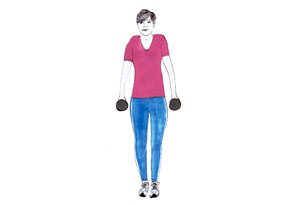
Illustration: Claire Mallison
Have long hours spent slumped over your computer turned you into the office hunchback? Here's how to work out the kinks.
Amy Markham was once an endurance athlete, running marathons and cycling long distances. Then, at the age of 37, she took a new job as director of admissions at a small liberal arts college in Massachusetts. Her new sport was hunching over her keyboard. At first the pain barely registered, but the tension in her neck and shoulders eventually became so severe that it was sometimes impossible to turn her head, shrug on clothes, or even type. While Markham's pain was extreme, the circumstances that led to it are not uncommon.
As many as 63 percent of all office workers will suffer from neck pain sometime this year, with women at particular risk, according to a recent comprehensive review of neck pain studies. Poor posture is partly to blame; the ever-increasing dependence on computers doesn't help, either. Happily, some relatively simple exercises can help.
5 moves that reduce neck pain and increase neck strength
Amy Markham was once an endurance athlete, running marathons and cycling long distances. Then, at the age of 37, she took a new job as director of admissions at a small liberal arts college in Massachusetts. Her new sport was hunching over her keyboard. At first the pain barely registered, but the tension in her neck and shoulders eventually became so severe that it was sometimes impossible to turn her head, shrug on clothes, or even type. While Markham's pain was extreme, the circumstances that led to it are not uncommon.
As many as 63 percent of all office workers will suffer from neck pain sometime this year, with women at particular risk, according to a recent comprehensive review of neck pain studies. Poor posture is partly to blame; the ever-increasing dependence on computers doesn't help, either. Happily, some relatively simple exercises can help.
5 moves that reduce neck pain and increase neck strength
A study published in the Journal of Applied Physiology found that the five moves below dramatically reduced neck pain and increased neck strength in female office workers. For the best results, complete at least three sessions a week. (A session consists of three sets of three of the moves listed here; for each set, repeat the exercise ten to 12 times.)
 1. Shoulder Shrug
1. Shoulder ShrugStand, holding a pair of two-pound dumbbells at your sides. Keeping your neck straight, slowly lift up your shoulders toward your ears and lower them again. Repeat.
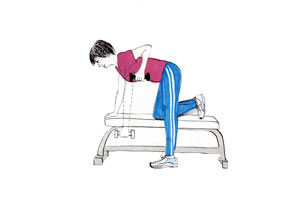 2. One-Arm Row
2. One-Arm RowWith a dumbbell in your left hand, stand at the left side of a knee-high workout bench. Set your right knee on the bench and bend at the waist, setting your right palm on the front of the bench for balance. Your left arm should be straight, palm facing in, with the weight hanging toward the ground. Slowly pull up the weight toward your chest, then gently lower and repeat. Switch sides and repeat with the opposite arm.
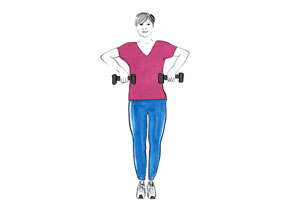 3. Upright Row
3. Upright RowStand holding a weight in each hand, resting the weights on your thighs, palms facing your body. Bending at the elbows, slowly lift up the dumbbells to chest height (your elbows should point slightly up, not straight out to either side). Keep the weights close to your body and your neck relaxed and straight. Lower gently and repeat.
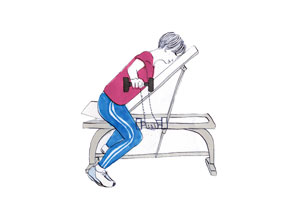 4. Reverse Fly
4. Reverse FlyReposition your bench so it's at a 45-degree angle to the floor. With a weight in each hand, straddle the seat and press your chest against the raised end of the bench. Extend your arms toward the floor, palms facing in. Keeping your elbows slightly bent, extend the weights out to your sides until your arms are parallel to the floor. Slowly lower and repeat.
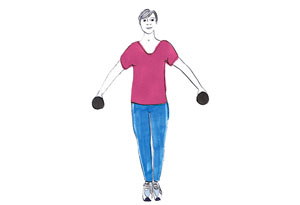 5. Shoulder Abduction
5. Shoulder AbductionStand holding the weights at your sides, pressed against your thighs. With your elbows slightly bent, extend the weights out to your sides until your arms are parallel to the floor, palms down. Keep your neck straight and relaxed. In a smooth motion, lower and repeat.
Create a perfect workstation for mind and body




